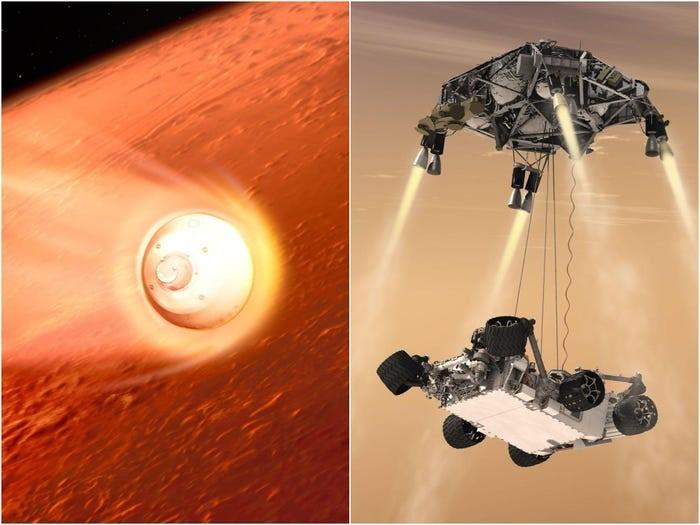
Date:
Left: Perseverance spacecraft entering the Martian atmosphere.
Right: Perseverance being lowered to the surface from 20m height.
Images curtesy of NASA
The latest addition to the suite of roving robotic laboratories exploring Mars arrives this afternoon. As big as a BMW coupe, the rover named ‘Perseverance’ screams through the Martian atmosphere at a blistering 13,000 mph around 3:30p EDT, still encased in its trans-Martian cruise shells. This is where the excitement begins after 7 months of quiet flight from Earth.
The riskiest part of the entire Mars mission is the entry, descent, and landing, called 'EDL'. It is extremely complicated and every step must execute perfectly - PERFECTLY! - or the craft breaks up as it descends or crashes on landing. To add to the tension, it’s all automatic! If something were to go wrong, we’re too far away to intervene in time. We’re so far away that we won’t know if it landed successfully until seven minutes AFTER it lands. Or crashes. This time period is known in the Mars business as the “Seven Minutes of Terror”. NASA engineers have confidence in their engineering but they're also quite nervous about it, as well they should be. Of 17 Russian attempts to reach Mars, only one, the Mars 3 lander, survived long enough to send an illegible image of the surface. NASA engineers, flight controllers and scientists will hold their collective breath until they know Perseverance is down safely.
- See this link first to set the stage - it's the description from the Curiosity rover’s landing in 2012.
- Here's a link to a video describing the ‘seven minutes’ for Perseverance.
- And here you'll find a pre-landing simulation detailing every aspect of the landing sequence in high-res CGI.
- Finally, here's the mission overview page at NASA's website. NASA TV will carry it live of course. You can follow either online or through your Apple TV box, etc.
Perseverance’s main science objectives are to look for signs of past microbial life, collect rock core and soil samples for return to Earth (NET 2031), test oxygen production from the Martian atmosphere in preparation for human explorers, and try to fly a helicopter in the thin Martian atmosphere.
Go Percy!


